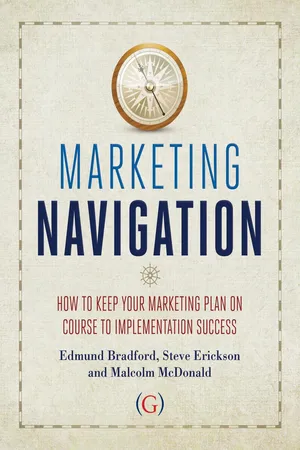Marketing
Marketing Plan
A marketing plan is a comprehensive document that outlines an organization's overall marketing efforts. It typically includes an analysis of the market, target audience, marketing goals, strategies, tactics, and budget. The plan serves as a roadmap for the marketing team to follow in order to achieve the company's objectives.
Written by Perlego with AI-assistance
Related key terms
1 of 5
12 Key excerpts on "Marketing Plan"
- eBook - PDF
- O. C. Ferrell, Michael Hartline, O. C. Ferrell, Michael Hartline, Bryan Hochstein(Authors)
- 2021(Publication Date)
- Cengage Learning EMEA(Publisher)
Chapter 2: Strategic Marketing Planning 43 day do little to help the organization meet its goals. Good Marketing Plans are those that are realistic and doable given the organization’s resources. ● ● Update regularly. Once the Marketing Plan has been developed and implemented, it should be updated regularly with the collection of new data and information. Many organizations update their Marketing Plans on a quarterly basis to ensure that the marketing strategy remains consistent with changes in the internal, customer, and external environments. Under this approach, you will always have a working plan that covers 12 months into the future. In some cases, especially when technology and competition are changing rapidly, the Marketing Plan may need to be updated as regularly as every month to address change and adapt plans accordingly. In all cases, the Marketing Plan should be looked at as a living document that provides a roadmap that sometimes requires detours to achieve overall goals. ● ● Communicate to others. One critical aspect of the Marketing Plan is its ability to communicate to colleagues, particularly top managers who look to the Marketing Plan for an explanation of the marketing strategy, as well as for a justification of needed resources, like the marketing budget. 13 The Marketing Plan also communicates to line managers and other employees by giving them points of reference to chart the progress of marketing implementation. A survey of marketing executives on the importance of the Marketing Plan revealed that “. . . the process of preparing the plan is more important than the document itself . . . . A Marketing Plan does compel attention, though. It makes the marketing team concentrate on the market, on the company’s objectives, and on the strategies and tactics appropriate to those objectives. - eBook - PDF
- Malcolm McDonald, Ailsa Kolsaker(Authors)
- 2017(Publication Date)
- Red Globe Press(Publisher)
Figure 7.4 highlights the need to plan and integrate the marketing mix elements against defined marketing objectives. The important process of defining marketing objectives and strategies is considered in Chapter 8. Corporate objective Marketing objective Price objectives Pricing plan Promotional plan Sales plan Advertising plan Sales promotion plan Channel plan Service plan Place plan Product plan Promotion objectives Place objectives Product objectives Figure 7.4 The marketing mix is defined against the marketing objectives Having completed this major planning task, it is normal at this stage to employ judgement, experience and field tests to assess the feasibility of the objectives and strategies in terms of market share, sales, costs and profits. PROGRAMMES The general marketing strategies are now deployed into specific ‘sub-objectives’, each supported by more detailed strategy and action statements, with timings and responsibilities clearly indicated. 123 CHAPTER 7 – Marketing PlanNING USE OF Marketing PlanS A written Marketing Plan is the background against which operational decisions are taken on an ongoing basis; consequently, too much detail should not be included. We should remember that its major function is to determine where the company is now , where it wants to go and how to get there. This is cen-tral to the company’s revenue-generating activities, and from it flow all other corporate activities, such as the timing of the cash flow and the size and char-acter of the labour force. Finally, the Marketing Plan should be distributed to those who need to know what is going on, since its purpose is an aid to effective management. INTERNATIONAL Marketing PlanNING The process of Marketing Planning outlined in this chapter is universally applicable, irrespective of company size and complexity. The only real dif-ference concerns the degree of formality of the processes and procedures. - Bonita M. Kolb(Author)
- 2016(Publication Date)
- Routledge(Publisher)
components , product, price, distribution, and promotion, to fulfill both the mission of the organization and the needs of the customer.- The process of writing a Marketing Plan will force the organization to answer difficult questions. An organization may have many ideas for future action, but as resources are limited, the plan will force the organization to make choices. Goals, objectives, and tactics that provide a roadmap of how to achieve these choices and how success can be measured will then be developed.
The relationship between strategic planning and marketing
New definitions for strategy and marketingThe world is much less static than in the past resulting in a new definition of strategy. Because consumers’ wants and needs constantly change as they access the continual stream of online information, the strategic planning process must be dynamic with constant revision as the plan is being implemented. As each action takes place, consumer feedback is assessed to see if changes must be made before the next step is taken.Strategy old definition : “Create unique and sustainable value by differentiating goods and services.”Strategy new definition : “Find unique, valuable, and sustainable ways of linking together a firm’s knowledge and skills with customers that will benefit from them.”How consumers use products has also changed. In the past, a company would provide instructions on product use and expect them to be followed. Now the consumer decides how to use the product and then shares this knowledge online with others. As a result, the company must provide information that suggests how the product can be used to meet the consumer’s needs but must still understand that each customer is unique and may use the product differently.- eBook - PDF
- Daniel Padgett, Andrew Loos(Authors)
- 2023(Publication Date)
- Wiley(Publisher)
• The typical organizational marketing structure depends to some extent on the size of the company, but in general there are three levels: (1) corporate, (2) strategic business unit (SBU) or business level, and (3) department level. Except in very small companies, marketing is usually a separate department within the company or business unit. • A mission statement is a definition of the firm’s business focus that provides direction for the company. • The most successful companies offer something others don’t, which suggests that another important element in the Marketing Plan is the description of what sets the company apart from its competition. An advantage over competitors gained by offering greater customer value, either by having lower prices or provid- ing more benefits that justify higher prices, is referred to as a competitive advantage. 2.2 Marketing Planning • Before a marketer decides what to do, she or he must understand the situation in great detail, as the situation dictates what is possi- ble and sets constraints on marketing activities. The most common approach for assessing the situation is to use a SWOT analysis. A SWOT analysis involves identifying internal strengths (S) and weaknesses (W) and external opportunities (O) and threats (T). • After the situation analysis and opportunity assessment, the next component of the Marketing Plan is to set marketing objectives. Generally, marketing objectives state what is to be accom- plished through the marketing efforts. • Once a company decides on objectives, it develops a Marketing Plan—a written document that guides marketing activities. • A Marketing Plan includes a description of the specific tools and tactics that will be used to achieve the marketing objectives and deliver the competitive advantage to customers. Marketers refer to the unique combination of marketing activities used to encourage and facilitate exchanges by delivering value to the customer as the marketing mix. - eBook - PDF
Marketing Navigation
How to keep your marketing plan on course to implementation success
- Edmund Bradford, Steve Erickson, Malcolm McDonald(Authors)
- 2012(Publication Date)
- Goodfellow Publishers(Publisher)
Marketing Navigation 44 Introduction Research into the efficacy of formalized Marketing Planning (Thompson 1962; Leighton 1966; Kollatt et al. 1972; Ansoff 1977; McDonald 1984; Greenley 1984; Piercy 1997; Smith 2003) has shown that Marketing Plan-ning can make a significant contribution to commercial success. The main effects within organizations are: The systematic identification of emerging opportunities and threats Preparedness to meet change The specification of sustainable competitive advantage Improved communication among executives Reduction of conflicts between individuals and departments The involvement of all levels of management in the planning process More appropriate allocation of scarce resources Consistency of approach across the organization A more market-focused orientation across the organization. However, although it can bring many benefits, a strategic Marketing Plan is mainly concerned with competitive advantage – that is to say, establishing, building, defending and maintaining it. In order to be realistic, it must take into account the organization’s existing competitive position, where it wants to be in the future, its capabilities and the competitive environment it faces. This means that the Marketing Planner must learn to use the various available processes and techniques which help to make sense of external trends, and to understand the organization’s traditional ways of responding to these. However, this poses the problem regarding which are the most rel-evant and useful tools and techniques, for each has strengths and weak-nesses and no individual concept or technique can satisfactorily describe and illuminate the whole picture. As with a jigsaw puzzle, a sense of unity only emerges as the various pieces are connected together. The links between strategy and performance have been the subject of detailed statistical analysis by the Strategic Planning Institute. - eBook - ePub
- Jeffrey H. Rattiner(Author)
- 2010(Publication Date)
- Bloomberg Press(Publisher)
Increasing referrals. Are you getting an increasing number of unsolicited inquiries about your firm? While you cannot be sure that new inquiries come from satisfied customers or are driven by advertising, you will know something is wrong if no one calls. You should have your front-office staff track new inquiries carefully and note call rates before and after promotional events. If the incoming call rate is increasing each month and positive blips occur around the time of a promotional event—usually within thirty to sixty days—then you are getting the combined benefit of word of mouth and marketing.• Increasing retention. One can argue that client retention is a function of the quality, value, and ongoing care you provide to your clients. However, client retention is also a function of your ability to design and communicate new products and services. The speed with which new products and services are adopted by clients is a measure of your marketing acumen.What Is a Marketing Plan?
MARKETING Is the process of finding and creating customers for your products and services. Sales is the process of transforming an interested prospect into a committed client. Your Marketing Plan is a written document that describes your targets, your message, the ways you plan to communicate your message, the costs involved, and the expected results. In essence, a Marketing Plan is a road map that helps you figure out the best way to reach your clientele. It helps you to understand your business thoroughly by requiring you to think and write about how to differentiate your services. If your message is not clear and different from the competition, no amount of hard work will yield increasing prices, margin per client, referrals, and retention.A Marketing Plan should be easy to comprehend, easy to follow, and based on a logical sequence of steps. Almost anyone—prospect or friend—should be able to understand, recite, and follow your plan. Ask your advisory board to add a professional touch to any rough edges or to mention opportunities you may have overlooked.Elements of a Marketing Plan
YOUR Marketing Plan will be a subsection of your overall business plan (see Chapter 6). Use the following basic elements to organize your thinking on marketing your start-up professional financial planning practice.• Executive summary • Market analysis and objectives • Developing marketing targets: attracting prospects, turning prospects into clients, retaining clients, building referrals, and niche positioning - eBook - PDF
- James Burrow(Author)
- 2020(Publication Date)
- Cengage Learning EMEA(Publisher)
Copyright 2021 Cengage Learning. All Rights Reserved. May not be copied, scanned, or duplicated, in whole or in part. Due to electronic rights, some third party content may be suppressed from the eBook and/or eChapter(s). Editorial review has deemed that any suppressed content does not materially affect the overall learning experience. Cengage Learning reserves the right to remove additional content at any time if subsequent rights restrictions require it. 9.4 | Marketing Planning 265 Specify the Marketing Mix A complete description of each mix ele- ment is included in the Marketing Plan. Product, distribution (place), price, and promotion are described specifically and completely so that everyone involved in implementing the mix understands the company’s plans. A description of the mar- keting mix is presented in the marketing strategy section of the Marketing Plan, and the activities and budgets needed to imple- ment each element of the mix are devel- oped in later sections. Develop a Positioning Statement A positioning statement is a specific description of the unique qualities of the marketing mix that make it different from the competition and satisfying to the target market. For example, a discount store posi- tions itself as the one-stop place to shop for home products for a family on a budget. and so it is clear that the marketing mix is appropriate for that target market. Although each target market is unique, it is possible for an organization to serve several target markets at once. When more than one market is identified, mar- keting planners must remember that each market requires a specific marketing mix. A specific product or target market may have its own Marketing Plan or a specific section of the overall company Marketing Plan devoted to it. - eBook - PDF
Marketing for the Nonmarketing Executive
An Integrated Resource Management Guide for the 21st Century
- Norton Paley(Author)
- 2000(Publication Date)
- CRC Press(Publisher)
Marketing Plan. There are no shortcuts. Such an approach avoids the realities of the volatile competitive environment. There are five sections that make up the tactical Marketing Plan: situation analy-sis, market opportunities, marketing objectives, strategies and action plans, and fi-nancial controls and budgets. S ITUATION A NALYSIS Key point: The situation analysis serves as foundation material for developing oppor-tunities, objectives, and strategies/tactics. The tactical Marketing Plan begins with a situation analysis for a specific product or market. Whereas the strategic plan looks forward three to five years, the situation analysis requires that you look back three to five years to obtain an historical per-spective of your business. This information is important because it serves as foundation material for devel-oping the opportunities, objectives, and strategies/tactics that follow. This informa-tion also highlights any gaps in knowledge that exist about markets and customers and suggests types of marketing research needed to make more precise decisions. Overall, as a nonmarketing manager, the analysis should give more valuable in-sights into your markets, and help assess the capabilities of your firm to maintain a viable position. The situation analysis is divided into three parts. Marketing mix — Here you objectively describe your product by the following characteristics: • Product’s sales history, profitability, share of market; position in the in-dustry related to market leadership, reputation, and stage in the product life cycle. • History of pricing policies by market segment and distribution channel. • Current distribution channels, effectiveness of market coverage, and key activities performed at each point of the distribution chain. - eBook - PDF
Marketing Planning by Design
Systematic Planning for Successful Marketing Strategy
- Ralf Strauss(Author)
- 2010(Publication Date)
- Wiley(Publisher)
The procedures for the market, enterprise, and competitive analysis must meet fundamental requirements, such as the information used being reliable and realistic. The information basis for drawing up the marketing strategy must be sufficiently detailed and precise to prevent purely intuitive decisions from being made. However, the information and analyses used must focus on the essentials and not generate an information overload as part of the strategy discussion. Formulation of the marketing strategy is then related to specific goals, target groups, or the design of the marketing mix for reaching the objectives set. In this phase, alternative marketing strategies are formulated as options, which are then further evaluated and consolidated as part of the continuing process, with one of the options finally being selected and adopted as the marketing strategy to be pursued. Through the systematic and well-grounded design of the Marketing Planning process – with customer needs and market potential as the starting point – the alignment with dif- ferent company areas (such as sales and distribution or service) and with global, regional, and local units becomes easier. Case studies reveal that, by using the approach outlined here, within a few weeks, Marketing Planning in its entirety – across all the areas involved – can be aligned in detail in terms of the most important dimensions: • Cross-area strategy; • Marketing programs and content; • Campaigns and tactics. Figure 4.1 Seven-phase model for systematic Marketing Planning (Strauss 2007). - eBook - PDF
Business Development
A Market-Oriented Perspective
- Hans Eibe Sørensen(Author)
- 2014(Publication Date)
- Wiley(Publisher)
Market demand refers to the total volume that would be bought of a particular product, by a defined customer group, in a defined geographical area and in a defined timeframe. Marketing management refers to the activities, set of institutions and processes for creating, communicating, delivering and exchanging offerings that have value for customers, clients, partners and society at large. The marketing mix, and its four P’s (product, price, place and promotion), is the set of parameters that the marketing manager actually can control, subject to the internal and external constraints of the marketing environment. A Marketing Plan is a formal statement, be it a standalone document or one integrated with a business plan, explaining how we deliver superior customer value to our target markets. An organization plan (of a business plan) explains how and with whom we orchestrate our resources, tasks and processes to create and deliver superior customer value. Perceived value refers to the consumer’s overall assessment of the utility of a product or service based on the perceptions of what is received and what is given. A perceptual map is a simple grid with two dimensions that reflect the dominant variables of differentiation in your target market. 392 B U S I N E S S D E V E L O P M E N T Positioning refers to the target market’s perception of your offering, in the sense that positioning is not what you do to the product but what you do to the mind of the customers in your target market. Positive disconfirmation of expectation occurs when customers get what they expect plus just a little bit more – but not too much – to get them back for a repurchase. Primary data is the raw data collected for a current research problem, which has yet to receive any meaningful interpretation. - eBook - ePub
- Jim Blythe(Author)
- 2012(Publication Date)
- Routledge(Publisher)
CHAPTER 2Planning within the Marketing Context
Learning objectives
After working through this module and reading around the subject, you should be able toExplain the importance of objectives, the processes for setting them and the influences upon them.Identify the various possible organisational objectives.Show how Marketing Planning is crucial in a market-oriented organisation.Describe the stages of the Marketing Planning process.Explain the concept of the marketing audit.STUDY TIPThis section accounts for 25% of the marks for the module, so (like Unit 1) it should account for about 10 hours of study time in total for the average student. If you do less than this, you will need to be exceptionally bright, or you will lose marks! You need to read around the subject, read the course textbook and think about what you are reading – what you learn is not only about passing the exams, it also prepares you for a successful career in marketing.SETTING OBJECTIVES
First, we need to distinguish between an aim and an objective. An aim is simply a statement of something we would like to do, for example, the firm might aim to be the best-respected in the industry, or we might aim for our promotional campaigns to be more memorable. These are not objectives. An objective is an aim which is measurable, that is, we have some means of knowing that we achieved the objective. Statements such as ‘we wish to sell as much as possible’ are aims, not objectives, because we have no real way of knowing how much ‘as much as possible’ actually is.Objectives are the building blocks of strategy. They are the basis for determining future direction, consistency, motivation and measurement of performance.EXAM TIPYou will often be asked to make recommendations for future action for a firm. You will gain marks if you think in terms of setting objectives for your recommendations, because this will make them more concrete. - eBook - PDF
- David C. Bojanic, Robert D. Reid(Authors)
- 2016(Publication Date)
- Wiley(Publisher)
Action plans are developed, indicating the specifics of what will hap- pen, when it will be done, and how the Marketing Plan will be implemented. This does not mean that it is inflexible, but a clear implementation plan remains important. Action plans should contain the following information: • Who will assume primary responsibility for each part of the action plan? • How will these individuals (teams) proceed to implement the action plan? • When should these individuals (teams) have the action plan completed? • What resources will be necessary to fully implement the action plan? • How will the results of the plan be evaluated? • What specific metrics will be used to measure success? Following the development of the action plans but before implementing them, managers must complete two activities. First, an implementation schedule must be developed. Because not all the action plans will be implemented at the same time, an orderly timetable or schedule will deter- mine when the various actions should be carried out. Second, a set of performance criteria for evaluating the relative success of the action plans must be established. Performance criteria should be measurable. It is important to remember that Marketing Planning is a continuous process requiring monitoring and adapting based on actual performance. Four key control areas exist to evaluate performance: sales, costs, profits, and consumers. These control areas closely relate to the types of objectives discussed earlier in this section. Sales control data should focus on the firm’s sales by market segment, market share, and sales input. The quantified sales objectives should be broken down on a quarterly basis by market seg- ment and used as a standard against which actual sales results can be compared. Managers should evaluate differences in terms of absolute dollar amount, as well as percentages that allow for easier comparisons.
Index pages curate the most relevant extracts from our library of academic textbooks. They’ve been created using an in-house natural language model (NLM), each adding context and meaning to key research topics.











